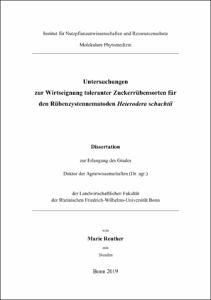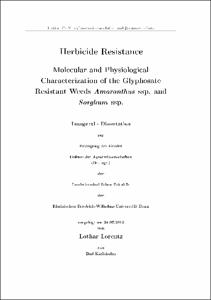Müller, Viola: Characterization of insecticide resistance in Hemipteran crop pests with special reference to aphids and whiteflies. - Bonn, 2024. - Dissertation, Rheinische Friedrich-Wilhelms-Universität Bonn.
Online-Ausgabe in bonndoc: https://nbn-resolving.org/urn:nbn:de:hbz:5-73326
Online-Ausgabe in bonndoc: https://nbn-resolving.org/urn:nbn:de:hbz:5-73326
@phdthesis{handle:20.500.11811/11270,
urn: https://nbn-resolving.org/urn:nbn:de:hbz:5-73326,
doi: https://doi.org/10.48565/bonndoc-208,
author = {{Viola Müller}},
title = {Characterization of insecticide resistance in Hemipteran crop pests with special reference to aphids and whiteflies},
school = {Rheinische Friedrich-Wilhelms-Universität Bonn},
year = 2024,
month = jan,
note = {Agriculture faces enormous challenges: In addition to the increasing demand for agricultural products with less available agricultural landscapes, there is a need to protect the environment and biodiversity and to minimize climatic emissions. In addition, agricultural food production is challenged by biotic factors as weed, pathogens and insect pests. The green peach aphid Myzus persicae, the pea aphid Acyrthosiphon pisum and the cabbage whitefly Aleyrodes proletella are among the most economically important insect pests worldwide. The one-sided usage of chemical insecticides is often causing insecticide resistance. In the present work, not yet documented insecticide resistance cases of the three pest species could be observed. By bioassays as well as molecular and biochemical diagnostic analyzes, resistance mechanisms were investigated to contribute to a successful integrated pest management.
In the green peach aphid, a 403-fold increase in tolerance to the 'transient receptor potential vanilloid' (TRPV) channel modulator pymetrozine was observed. In two comparative RNA sequencing approaches using Illumina and 'Oxford Nanopore Technology' (ONT) as well as amplicon sequencing using ONT, no mutations in the TRPV channel were detected. In contrast, overexpressed esterases FE4 and E4 as well as cytochrome P450s monooxygenases (CYP, P450s), were uncovered in the pymetrozine resistant strain. In other insects as the cotton whitefly Bemisia tabaci, overexpressed P450s have already led to pymetrozine resistance. The influence of overexpressed esterases and P450s on pymetrozine resistance in M. persicae needs to be elaborated in further studies.
In contrast, a P450 gene, CYP6CY12, could be linked to >180-fold pyrethroid resistance in pea aphids A. pisum. After detecting no relevant mutations in the sodium channel, the target-site of pyrethroids, an over 30-fold overexpression of CYP6CY12 was reported by Illumina transcriptome sequencing. UPLC-MS/MS analysis and enzyme kinetic studies provided evidence that deltamethrin is degraded by the protein to its metabolite 4'OH-deltamethrin. In addition to , three other CYP6CY P450s are already known which have led to insecticide resistance in aphids. For example, CYP6CY3 which caused resistance to nicotine and neonicotinoids in M. persicae.
In addition to the demonstrated metabolic resistance in pea aphids, target site resistance to spiromesifen and cross-resistance to spirotetramat were uncovered in A. proletella. The A2083V mutation which is located in the CT domain of Acetyl-CoA carboxylase (ACC) was identified by pyrosequencing in several strains from Europe. The mutation already resulted in ketoenol resistance in B. tabaci.
In the present work, important insecticide resistance cases were analyzed and uncovered. The elucidation of insecticide resistance mechanisms provides an important contribution to successful integrated pest management.},
url = {https://hdl.handle.net/20.500.11811/11270}
}
urn: https://nbn-resolving.org/urn:nbn:de:hbz:5-73326,
doi: https://doi.org/10.48565/bonndoc-208,
author = {{Viola Müller}},
title = {Characterization of insecticide resistance in Hemipteran crop pests with special reference to aphids and whiteflies},
school = {Rheinische Friedrich-Wilhelms-Universität Bonn},
year = 2024,
month = jan,
note = {Agriculture faces enormous challenges: In addition to the increasing demand for agricultural products with less available agricultural landscapes, there is a need to protect the environment and biodiversity and to minimize climatic emissions. In addition, agricultural food production is challenged by biotic factors as weed, pathogens and insect pests. The green peach aphid Myzus persicae, the pea aphid Acyrthosiphon pisum and the cabbage whitefly Aleyrodes proletella are among the most economically important insect pests worldwide. The one-sided usage of chemical insecticides is often causing insecticide resistance. In the present work, not yet documented insecticide resistance cases of the three pest species could be observed. By bioassays as well as molecular and biochemical diagnostic analyzes, resistance mechanisms were investigated to contribute to a successful integrated pest management.
In the green peach aphid, a 403-fold increase in tolerance to the 'transient receptor potential vanilloid' (TRPV) channel modulator pymetrozine was observed. In two comparative RNA sequencing approaches using Illumina and 'Oxford Nanopore Technology' (ONT) as well as amplicon sequencing using ONT, no mutations in the TRPV channel were detected. In contrast, overexpressed esterases FE4 and E4 as well as cytochrome P450s monooxygenases (CYP, P450s), were uncovered in the pymetrozine resistant strain. In other insects as the cotton whitefly Bemisia tabaci, overexpressed P450s have already led to pymetrozine resistance. The influence of overexpressed esterases and P450s on pymetrozine resistance in M. persicae needs to be elaborated in further studies.
In contrast, a P450 gene, CYP6CY12, could be linked to >180-fold pyrethroid resistance in pea aphids A. pisum. After detecting no relevant mutations in the sodium channel, the target-site of pyrethroids, an over 30-fold overexpression of CYP6CY12 was reported by Illumina transcriptome sequencing. UPLC-MS/MS analysis and enzyme kinetic studies provided evidence that deltamethrin is degraded by the protein to its metabolite 4'OH-deltamethrin. In addition to , three other CYP6CY P450s are already known which have led to insecticide resistance in aphids. For example, CYP6CY3 which caused resistance to nicotine and neonicotinoids in M. persicae.
In addition to the demonstrated metabolic resistance in pea aphids, target site resistance to spiromesifen and cross-resistance to spirotetramat were uncovered in A. proletella. The A2083V mutation which is located in the CT domain of Acetyl-CoA carboxylase (ACC) was identified by pyrosequencing in several strains from Europe. The mutation already resulted in ketoenol resistance in B. tabaci.
In the present work, important insecticide resistance cases were analyzed and uncovered. The elucidation of insecticide resistance mechanisms provides an important contribution to successful integrated pest management.},
url = {https://hdl.handle.net/20.500.11811/11270}
}









